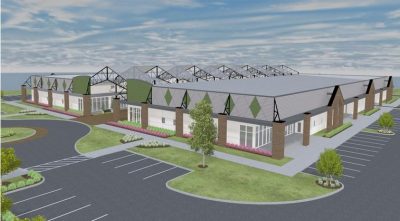Entrepreneurs look toward new ‘tech city’
eda is excited to be a part of the San Felasco Tech City team! Our surveyors, planners, and engineers have been working hard on this innovative project. Here’s an interesting article recently published in The Gainesville Sun about the development
Mitch Glaeser and Rich Blaser are developing a live-work-play hub in Alachua, called the San Felasco Tech City.
Tucked in Alachua off of U.S. 441, a plan for a new kind of city is in the works.
Mitch Glaeser, CEO of the Emory Group of Companies, and Rich Blaser, CEO of Infinite Energy, are developing their vision for the San Felasco Tech City into reality.
The tech city is still in its design stages, but Glaeser expects to be able to pull permits next month. The project is working with the University of Florida School of Architecture to design some of the area’s highlights. The groundbreaking is to start in August. And come March 2019, the buildings should be delivered.
“The San Felasco Tech City is really about being a better community,” Glaeser said.
The 60,000-square-foot area will be a mix of work space, living space and recreational areas. Glaeser and his team are looking into what millennial workers want, and they’re focusing on minimalist design, environmental care and recreational room.
The first of three phases represents a $9 million investment, according to Glaeser. The project eventually will encompass 55 acres.
He’s looking to create a new home from growing businesses and startups in the community, including his own Emory Group of Companies.
Today in HistorySix companies already have dibs on 42,500 square feet of the project. One of them is Fracture, a Gainesville-based company that prints images on glass. Currently, the company is outgrowing its Innovation Square home, co-founder and CEO Abhi Lokesh said.
“Right now we’re kind of bursting at the seams and playing tetris in this facility,” Lokesh said. “It’s a good problem to have, and I’m grateful for it, but there comes a time when it limits your ceiling.”
The company has about 50 workers now, he said, and moving into the tech city “gives us the ability about not even thinking twice about doubling if we need to.”
The extra space will also allow the company to have studio space and more room for collaboration. It will be nice, he said, to invite business partners and vendors down to their office because they have room to host.
The San Felasco Tech City’s inspiration board includes tiny homes, treehouses, Native American architecture, repetitive design and shade.
UF architecture students will be able to enter three contests: one for a 150-foot multi-use observation tower, one for solar trees and another for a pedestrian flyover above U.S. 441. The top three designs for each contest will receive prize money.
Solar panels over pedestrian areas, solar roofs and solar trees are expected to generate more than 1 megawatt of power, and that power should sustainably cover the tech city’s energy consumption.
Glaeser said the tech city will merge into the San Felasco Hammock Preserve, essentially opening the project up to 7,200 acres of nature and 30 miles of bike paths.
Tiny homes should be cheaper than traditional homes, Glaeser said, but there’s a plan for for employees to receive vouchers to live in the tech city, he said, to make housing more affordable.
He also wants to meet with representatives from UF, Santa Fe College and Alachua County Public Schools to discuss the possibility of feeder programs and other benefits.
Lokesh said the project’s emphasis on camaraderie, sustainability and environmental awareness aligns with Fracture’s own values.
“It’s a huge recruiting tool,” he said. “It’s important to have a workspace that people feel excited about.”



